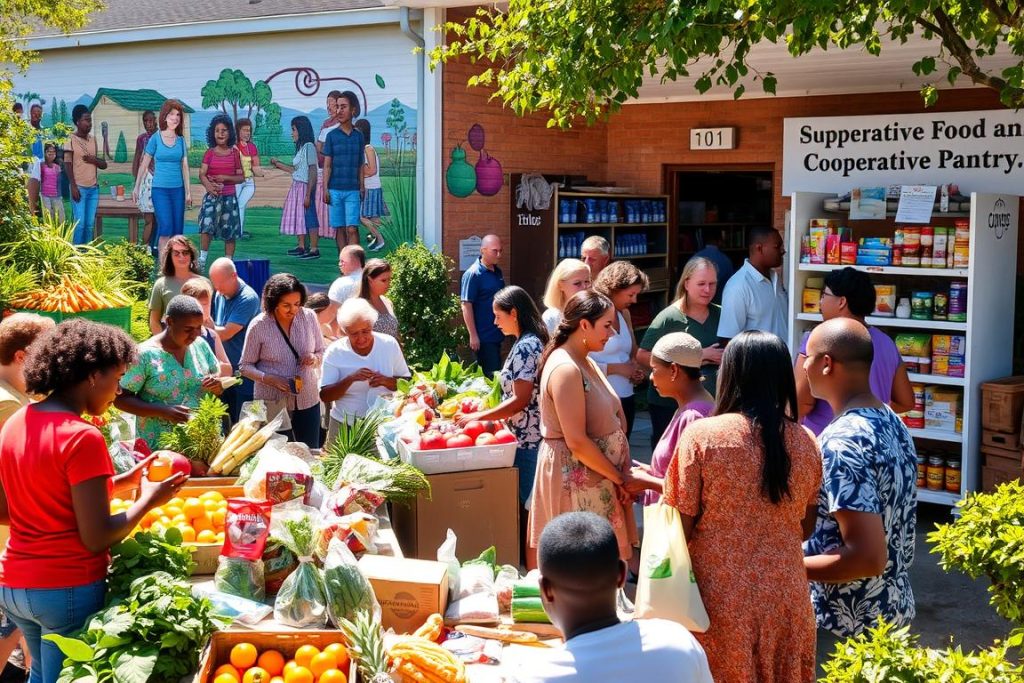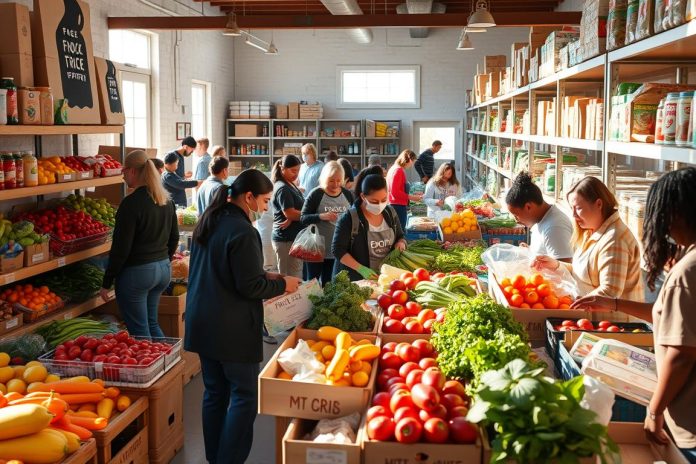Looking at your grocery bill can be shocking. The costs just keep climbing. This is a common issue for many people in America today. They face the hard job of affording their next meal as food prices rise. But there’s hope. Programs exist that offer grocery help. This help is a light in the dark for those struggling to get enough food. It’s not only about having food to eat. It’s also about having healthy food that keeps us well. Imagine the meals you could have with up to $1,386 in monthly food aid. This help isn’t far out of reach. Soon, we’ll show how you can get this vital support.
Finding these assistance programs can feel tricky and complex. But you’re not on your own. We will guide you, making it easier to understand. These programs aim to reduce your stress about grocery costs. They make sure getting healthy, affordable food is possible. With the right help, accessing food can become a reality, not a constant worry.
Key Takeaways
- Identify grocery assistance programs that offer substantial monthly food aid.
- Understand the impact of these programs on alleviating food insecurity.
- Recognize the potential for significant grocery bill reductions with the right food insecurity help.
- Discover easy steps to gain access to groceries through various assistance options.
- Learn how you can apply and meet the eligibility criteria for food aid programs.
Understanding Your Food Assistance Options
In the U.S., a wealthy nation, it’s sad to see many facing food insecurity. For those in need, it’s important to find food insecurity help. Help like hunger relief services and emergency food services can make a big difference. This part talks about resources that can help ensure you get enough to eat.
The Reality of Food Insecurity in the U.S.
Despite its wealth, many in the U.S. don’t know where their next meal is coming from. This major issue shows the importance of local food assistance programs. These programs are critical in providing necessary food to those in need.
What Are Food Assistance Programs?
Assistance comes from places like government programs, non-profits, and community efforts. Their main goals are to stop hunger, offer emergency food services, and food insecurity help. SNAP is a key program that lets eligible people buy essentials like fruits and vegetables. Find out more about using SNAP here.
Eligibility Criteria for Food Aid Programs
To join these food aid programs, you must meet certain eligibility criteria for food aid programs. These include your income, household size, and financial situation. These details help ensure the programs reach those who really need food assistance programs.
| Program | Eligibility Criteria | Benefits Offered |
|---|---|---|
| SNAP | Income must be at or below 130% of the federal poverty line | Monthly funds for buying groceries |
| WIC | Pregnant, postpartum, and breastfeeding women; children up to age 5 | Access to healthy foods, nutrition education |
| Local Food Banks | No strict eligibility; varies by location | Immediate food assistance, emergency food services |
Knowing about these options and their benefits is your first step to nutritional security. Local and national programs are ready to help. But, knowing how to find and use these free meal programs and services is crucial.
Grocery Assistance Programs Available to You
There are many grocery assistance options today. Knowing about them can help you stretch your budget and keep a healthy diet. In the U.S., there are federal and local programs to help individuals and families. Let’s look at some options that might help you.
Community food resources are key for immediate relief against hunger. They include food banks, food pantries, and soup kitchens. These places offer free groceries and meals to those in need. By using these resources, you can get fresh produce, dairy, and other essential items in your neighborhood.
- Federal Programs: Federally-funded programs like the Supplemental Nutrition Assistance Program (SNAP) offer monthly benefits to buy groceries at various retailers.
- Local Pantries: Local charities and religious organizations frequently operate food pantries which provide pre-packaged food parcels without cost.
- Emergency Food Assistance: For urgent situations, many local food assistance programs partner with other social services to provide immediate aid.
Choosing the Right Local Food Assistance Program
Every community has unique food assistance offerings. To find what fits your needs, consider factors like eligibility, nearby locations, and type of help. Families with children may prefer programs with high-nutrition options.
| Type of Aid | Description | Typical Qualification |
|---|---|---|
| Federal Assistance (SNAP) | Benefit card used for purchasing food items at stores. | Income-based eligibility. |
| Local Food Banks | Access to free groceries and fresh produce. | Often no income requirements, need-based. |
| Meal Programs | Soup kitchens providing hot meals. | Typically open to all, focus on homeless or low-income individuals. |
As you look into grocery assistance options, remember each program is here to help during tough times. Using these programs offers nutritional support and connects you with a caring community. This can help you manage your food needs more effectively.

Conclusion
Grocery help plays a vital role for many in America. Facing food insecurity is tough. Access to food pantries and emergency services can change lives. These resources offer immediate help and a path to long-term stability. Using them shows strength, not weakness.
These programs are more than just a quick fix. They help improve life quality. Learning about eligibility and how to access these aids is crucial. They ensure you meet basic needs without financial stress.
If you’re finding it hard at the grocery store, look into grocery assistance. It’s not just about surviving; it’s about thriving. Knowledge is indeed power. Equip yourself with this information. Make sure to seek the support you and your loved ones need. It’s your right and it’s there for you.

